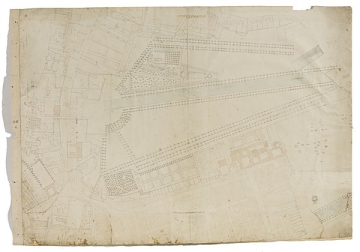Scale
10 feet to 1/16 inch (i.e. 100 feet to 5/8 inch) (prick-marked scale, at top left)
Inscribed
In pencil, on lower right, in a C18-19 hand, An Old Plan of St James's Palace (repeated below left, but erased, and with erased pencil inscriptions by Arthur Bolton to right); and in pencil at bottom right corner, 30
Signed and dated
Medium and dimensions
Pen and grey ink with light pink and light blue washes, over pencil under drawing, with a pencil-sketching on left, extensively pricked through for transfer; on laid paper, with C19 wove paper reinforcements on the verso, that on the left side (recto) extended to form gutter in former bound volume; 538 x 755.
Hand
Unidentified
Watermark
Strasbourg Lily / LVG = IHS / IVILLEDARY
Notes
The survey can be dated between the completion of St Martin-in-the-Fields (shown with its portico and the sloping line of the front steps, executed by then, bottom left) and the start of work on the Great Stable of the Royal Mews (1731-33) on the axis of St Martin's at the south end of the Great Mews Courtyard (see The History of the King's Works, vol. V, 1976, fig. 12 and pp. 212-13). Over the site of Whitehall Palace, including the Banqueting House, has been sketched in pencil an outline block plan for a large new building on an H-plan, the centre of its long west side (the right-hand leg of the H) overlapping the east end of the canal in St James's Park. It does not relate to any of the rebuilding schemes drawn by Hawksmoor soon after the fire in January 1698 and may therefore be an unrecorded scheme (perhaps also by Hawksmoor) for rebuilding the palace early in the reign of George II. The Banqueting House would have stood at the lower left-hand corner of the bar of the H (presumably retained rather than demolished).
Level
Drawing
Digitisation of the Drawings Collection has been made possible through the generosity of the Leon Levy Foundation
Sir John Soane's collection includes some 30,000 architectural,
design and topographical drawings which is a very important resource for
scholars worldwide. His was the first architect’s collection to attempt to
preserve the best in design for the architectural profession in the future, and
it did so by assembling as exemplars surviving drawings by great Renaissance
masters and by the leading architects in Britain in the 17th and 18th centuries
and his near contemporaries such as Sir William Chambers, Robert Adam and
George Dance the Younger. These drawings sit side by side with 9,000 drawings
in Soane’s own hand or those of the pupils in his office, covering his early
work as a student, his time in Italy and the drawings produced in the course of
his architectural practice from 1780 until the 1830s.
Browse (via the vertical menu to the left) and search results for Drawings include a mixture of
Concise catalogue records – drawn from an outline list of the collection – and
fuller records where drawings have been catalogued in more detail (an ongoing
process).


